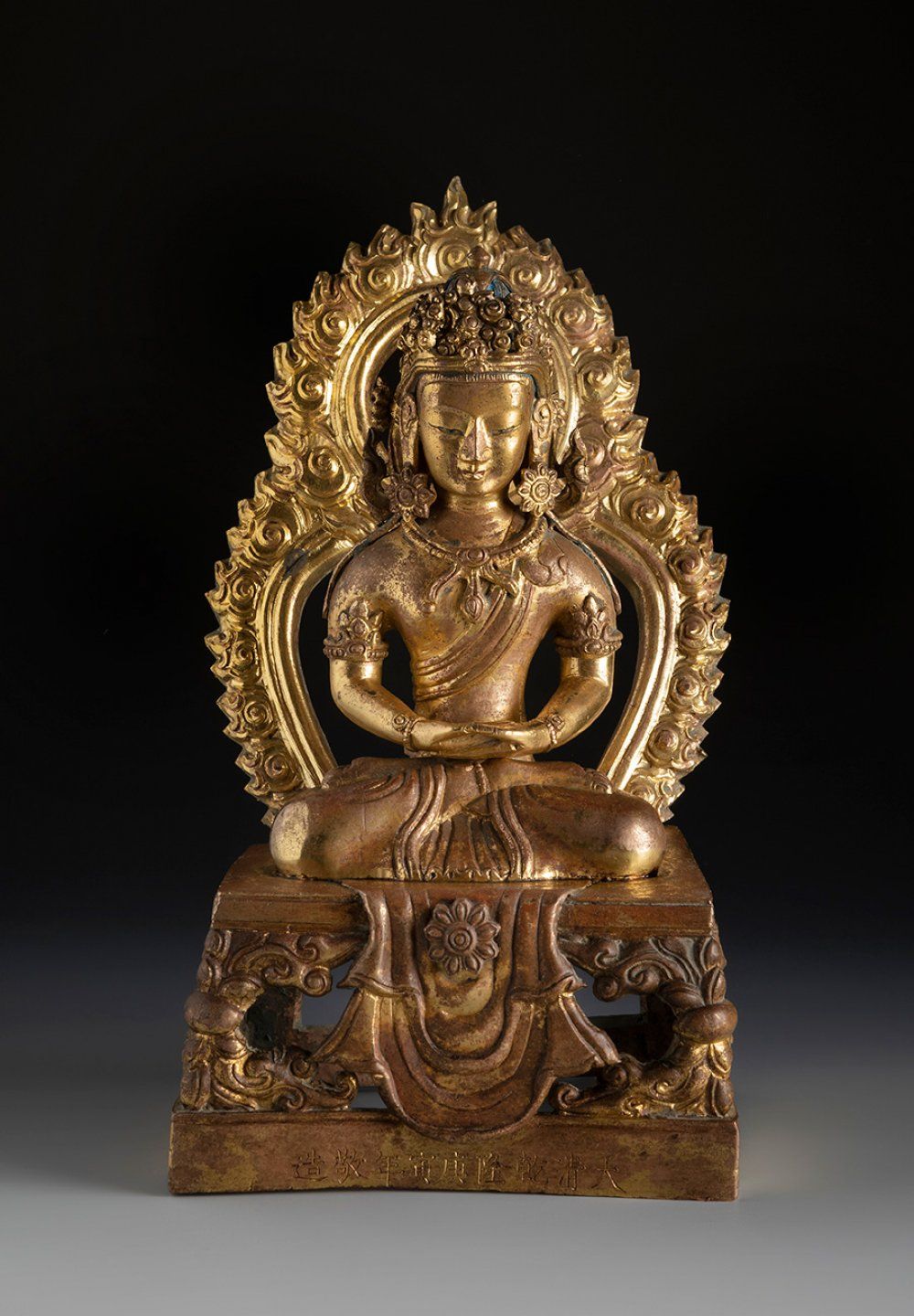Description
Buddha Amitayus. China, Qianlong period, 1770. Gilt bronze. Sealed on the inside of the base. With inscription 'Respectfully made in the year of Geng Yin, Qianlong, Qing Dynasty' on the front. According to the traditional Chinese method of counting years, the year Geng Yin corresponds to the 60th birthday of Emperor Quianlong. Parallels: A copy, albeit with a vase as an attribute, was exhibited and published in Chang Foundation, Taipei, Buddhist Images in Gilt Metal, Taipei, 1993, no. 21. This example of Amitayus seated was one of those commissioned by the Qianlong Emperor to celebrate his sixtieth birthday, as well as that of the Empress Dowager. It does not retain the attribute she holds in her hands. The stability of the piece is affected by an unevenness in the lower part of the base. Measurements: 20 x 11 x 9 cm. Amitayus, the Buddha of Eternal Life and Eternal Light, has been represented with singular refinement in this gilded bronze sculpture. Seated in the lotus position, with his hands performing a mudra, he rests on a pedestal of openwork vegetal forms. With his hands he performs the mudra of meditation, an attitude of inner contemplation and the willingness to listen to and receive what is being transmitted to us. The eyelids are slightly bent as a symbol of spiritual concentration and purity due to their similarity to the petals of the lotus. The serene face is illuminated by a barely hinted smile. A sinuous line follows the lip profile, marking with similar delicacy the perfect arch of the eyebrows, the almond-shaped eye sockets and the bridge of the nose. Each curve has been meditated and balanced to communicate the serenity characteristic of a perfect being. The elongated earlobes allude to the large earrings worn by members of the noble classes and represent the concepts of greatness, nobility and wisdom. In this case, the figure wears sumptuous earrings, and the care taken in the ornamentation continues in the strings of jewels on the necklaces. The headdress is finished off with a pagoda-shaped bun, this assimilation of the hairstyle to the Buddhist temple being typical of Buddhist art. The figure is completed by a completely detachable backlight.
53
Buddha Amitayus. China, Qianlong period, 1770. Gilt bronze. Sealed on the inside of the base. With inscription 'Respectfully made in the year of Geng Yin, Qianlong, Qing Dynasty' on the front. According to the traditional Chinese method of counting years, the year Geng Yin corresponds to the 60th birthday of Emperor Quianlong. Parallels: A copy, albeit with a vase as an attribute, was exhibited and published in Chang Foundation, Taipei, Buddhist Images in Gilt Metal, Taipei, 1993, no. 21. This example of Amitayus seated was one of those commissioned by the Qianlong Emperor to celebrate his sixtieth birthday, as well as that of the Empress Dowager. It does not retain the attribute she holds in her hands. The stability of the piece is affected by an unevenness in the lower part of the base. Measurements: 20 x 11 x 9 cm. Amitayus, the Buddha of Eternal Life and Eternal Light, has been represented with singular refinement in this gilded bronze sculpture. Seated in the lotus position, with his hands performing a mudra, he rests on a pedestal of openwork vegetal forms. With his hands he performs the mudra of meditation, an attitude of inner contemplation and the willingness to listen to and receive what is being transmitted to us. The eyelids are slightly bent as a symbol of spiritual concentration and purity due to their similarity to the petals of the lotus. The serene face is illuminated by a barely hinted smile. A sinuous line follows the lip profile, marking with similar delicacy the perfect arch of the eyebrows, the almond-shaped eye sockets and the bridge of the nose. Each curve has been meditated and balanced to communicate the serenity characteristic of a perfect being. The elongated earlobes allude to the large earrings worn by members of the noble classes and represent the concepts of greatness, nobility and wisdom. In this case, the figure wears sumptuous earrings, and the care taken in the ornamentation continues in the strings of jewels on the necklaces. The headdress is finished off with a pagoda-shaped bun, this assimilation of the hairstyle to the Buddhist temple being typical of Buddhist art. The figure is completed by a completely detachable backlight.
